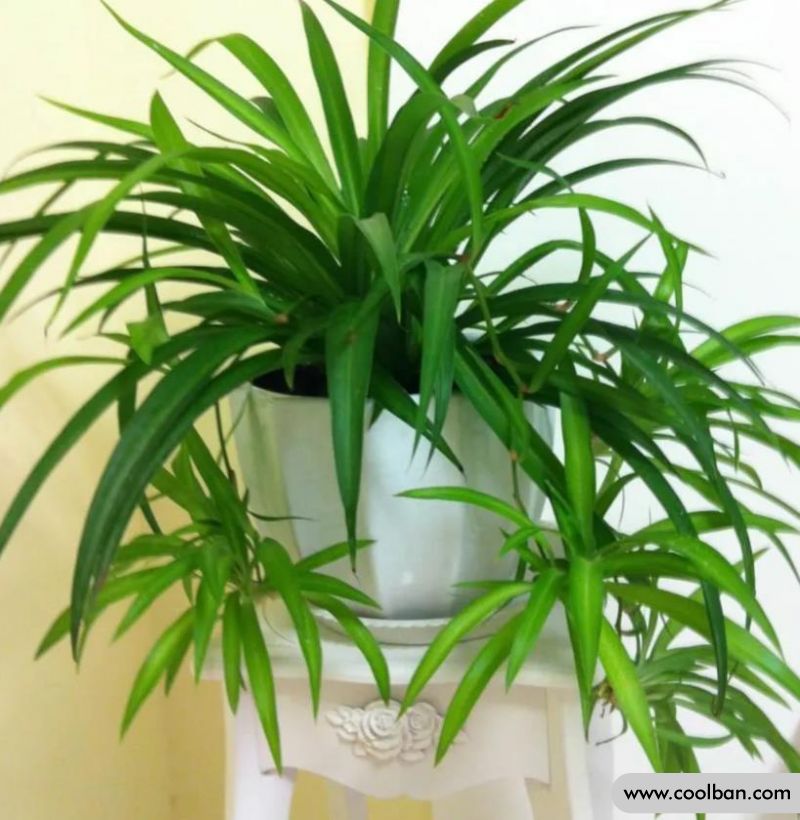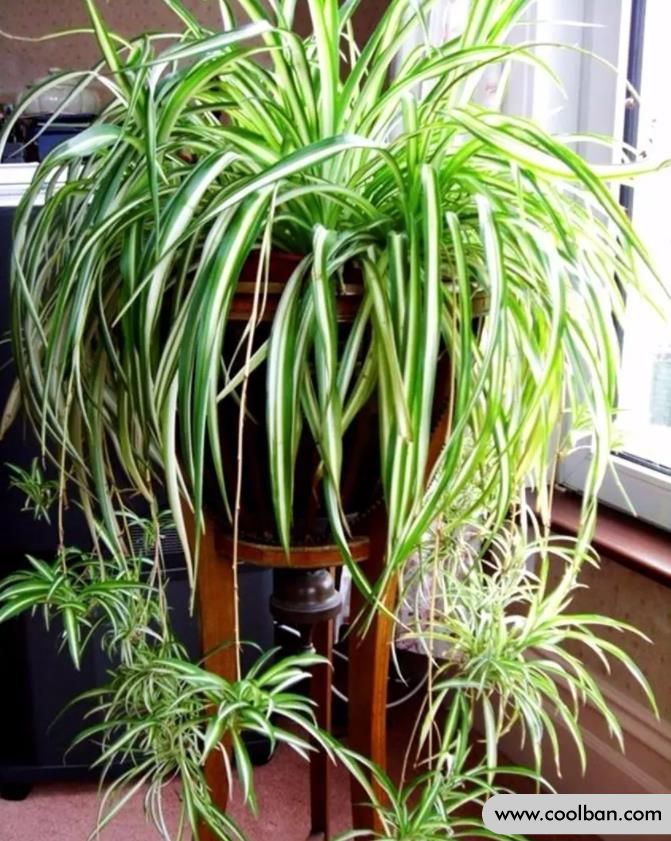Planting method of spider plants
2022-05-09
Chlorophytum is a perennial evergreen herb of the Liliaceae family. Chlorophytum is named after its roots and leaves resemble orchids, and the flower stalks extend horizontally and hang upside down. Chlorophytum can be enjoyed for many years in a bright room. It has peculiar stems, drooping branches and leaves, beautiful leaves, elegant and pure, evergreen all year round, very unique, and is an excellent indoor potted foliage flower. Because of its many varieties, large changes in leaf color, and easy cultivation, it is very popular among people.

Cultivation method of spider plants
Chlorophytum can be propagated by cuttings, divisions, and sowing. Cuttings can be propagated at any time from spring to autumn. Chlorophytum has strong adaptability, high survival rate, and is generally easy to reproduce. When cutting, take 5-10 cm long sprout stolons and insert them into the soil, and they can take root in about a week. It can be transplanted into a flowerpot in about 20 days, watered well, and placed in a cool place for maintenance.
Chlorophytum is of various shapes, strong shade tolerance, and easy to manage. Commonly used for hanging potted plants for interior decoration or garden landscaping. Its breeding should master the following points:
Cultivation of spider plants Method 1: Temperature adjustment. Chlorophytum likes warm and humid climates and is not cold-resistant. 20-24°C grows the fastest, and stops growing above 30°C, and the leaves are prone to yellow and dry shoots.
Cultivation of spider plants Method 2: Lighting adjustment. In summer, outdoor cultivation should pay attention to shading, and the light should not be too strong, otherwise it is easy to get sunburned.
Cultivation of spider plants Method 3: Water and fertilizer adjustment. During the peak growth season in spring and autumn, watering should be sufficient, the basin soil should be kept moist frequently, and the branches and leaves should be sprayed with water close to room temperature to prevent withering, but water should not be accumulated.
Cultivation of spider plants Method 4: Pruning and changing pots. As the plant grows, in order to maintain a good plant shape, the old leaves at the base should be pruned frequently.
Cultivation of spider plants Method 5: pest control. Chlorophytum plants are densely dense and poorly ventilated, and are vulnerable to scale insects, so prevention should be the main focus.

Precautions for spider plant cultivation
Cultivation of Chlorophytum Note 1: Chlorophytum is a fertilizer-tolerant plant, with insufficient nutrients, the leaves turn yellow, and are prone to scorch and senescence.
Cultivation of spider plants Note 2: Half shade is best in spring and autumn. In summer, it is advisable to see light in the morning and evening, shade at noon, and avoid sunlight. In winter, the sun is more common, and the basin soil is moist during the growth period, and water can not be accumulated.
Note 3: Change the pot once a year in spring (mid-late March).
Cultivation of spider plants Note 4: Avoid direct sunlight in summer. Always keep the potting soil moist. Water with liquid fertilizer every 15-20 days.
Cultivation of Chlorophytum Note 5: After mid-October, hang the flowerpot in a position close to the sun and easy to see. In winter, water when the soil surface is about 1 cm deep to dry.
Cultivation of spider plants Note 6: When the climate is dry in summer and autumn, measures such as spraying water should be taken to increase the air humidity around the plant.
Note 7: The potting soil should be kept dry in winter. If the pot soil is too wet, it will induce botrytis and leaf rot.
Cultivation of spider plants Note 8: The indoor light should not be too dark, otherwise the leaf color will become lighter or yellow-green.
Note 9: Watering should be avoided in the heart of the plant, otherwise it will easily cause the young leaves to rot.
Cultivation of spider plants Note 10: Too much fertilization exceeds the plant's requirement. The leaves are shiny and jagged at first, and when the root system rots, the leaves turn yellow. Fertilize should be stopped, water more, or turn over the pot to clean the roots and replace with new soil.
Cultivation of spider plants Note 11: If the pot is not turned over for a long time, the various nutrients contained in the pot soil have been exhausted, and the three elements of nitrogen, phosphorus and potassium have not been replenished in time , the plants lack nutrients and the leaves look yellow and thin. It should be replaced with fertile loam and fertile water in time.

What should I do if the leaves of the spider plant turn yellow
The yellowing of the leaves of the spider plant is caused by a variety of reasons, and corresponding measures should be taken to improve the yellowing of the leaves of the spider plant.
Treatment 1: Fertilize too much, more than the plant needs. The initial leaves are shiny and uneven, and the leaves turn yellow after the root system rots. Fertilize should be stopped, water more, or turn over the pot to clean the roots and replace with new soil.
Treatment method 2: The soil has not been turned for a long time. The various nutrients contained in the basin soil have been exhausted, and the three elements of nitrogen, phosphorus and potassium have not been supplemented in time, the plants lack nutrients, and the leaves appear yellow and thin. It should be replaced with fertile loam and fertile water in time.
Treatment method 3: Although Chlorophytum is a semi-negative flower, it needs at least four hours of astigmatism every day, otherwise the chlorophyll will decrease and the leaves will turn yellow.
Treatment method 4: The basin soil has poor air permeability and water permeability. If the pot soil is waterlogged for a long time, it will make it difficult for the roots to breathe and cause the leaves to turn yellow. The soil should be loosened and moisture should be controlled in time.
Treatment method 5: No watering for a long time. The roots of Chlorophytum lose water, and the lower old leaves turn yellow. Water well to keep the soil warm and moist.

Cultivation method of spider plants
Chlorophytum can be propagated by cuttings, divisions, and sowing. Cuttings can be propagated at any time from spring to autumn. Chlorophytum has strong adaptability, high survival rate, and is generally easy to reproduce. When cutting, take 5-10 cm long sprout stolons and insert them into the soil, and they can take root in about a week. It can be transplanted into a flowerpot in about 20 days, watered well, and placed in a cool place for maintenance.
Chlorophytum is of various shapes, strong shade tolerance, and easy to manage. Commonly used for hanging potted plants for interior decoration or garden landscaping. Its breeding should master the following points:
Cultivation of spider plants Method 1: Temperature adjustment. Chlorophytum likes warm and humid climates and is not cold-resistant. 20-24°C grows the fastest, and stops growing above 30°C, and the leaves are prone to yellow and dry shoots.
Cultivation of spider plants Method 2: Lighting adjustment. In summer, outdoor cultivation should pay attention to shading, and the light should not be too strong, otherwise it is easy to get sunburned.
Cultivation of spider plants Method 3: Water and fertilizer adjustment. During the peak growth season in spring and autumn, watering should be sufficient, the basin soil should be kept moist frequently, and the branches and leaves should be sprayed with water close to room temperature to prevent withering, but water should not be accumulated.
Cultivation of spider plants Method 4: Pruning and changing pots. As the plant grows, in order to maintain a good plant shape, the old leaves at the base should be pruned frequently.
Cultivation of spider plants Method 5: pest control. Chlorophytum plants are densely dense and poorly ventilated, and are vulnerable to scale insects, so prevention should be the main focus.

Precautions for spider plant cultivation
Cultivation of Chlorophytum Note 1: Chlorophytum is a fertilizer-tolerant plant, with insufficient nutrients, the leaves turn yellow, and are prone to scorch and senescence.
Cultivation of spider plants Note 2: Half shade is best in spring and autumn. In summer, it is advisable to see light in the morning and evening, shade at noon, and avoid sunlight. In winter, the sun is more common, and the basin soil is moist during the growth period, and water can not be accumulated.
Note 3: Change the pot once a year in spring (mid-late March).
Cultivation of spider plants Note 4: Avoid direct sunlight in summer. Always keep the potting soil moist. Water with liquid fertilizer every 15-20 days.
Cultivation of Chlorophytum Note 5: After mid-October, hang the flowerpot in a position close to the sun and easy to see. In winter, water when the soil surface is about 1 cm deep to dry.
Cultivation of spider plants Note 6: When the climate is dry in summer and autumn, measures such as spraying water should be taken to increase the air humidity around the plant.
Note 7: The potting soil should be kept dry in winter. If the pot soil is too wet, it will induce botrytis and leaf rot.
Cultivation of spider plants Note 8: The indoor light should not be too dark, otherwise the leaf color will become lighter or yellow-green.
Note 9: Watering should be avoided in the heart of the plant, otherwise it will easily cause the young leaves to rot.
Cultivation of spider plants Note 10: Too much fertilization exceeds the plant's requirement. The leaves are shiny and jagged at first, and when the root system rots, the leaves turn yellow. Fertilize should be stopped, water more, or turn over the pot to clean the roots and replace with new soil.
Cultivation of spider plants Note 11: If the pot is not turned over for a long time, the various nutrients contained in the pot soil have been exhausted, and the three elements of nitrogen, phosphorus and potassium have not been replenished in time , the plants lack nutrients and the leaves look yellow and thin. It should be replaced with fertile loam and fertile water in time.

What should I do if the leaves of the spider plant turn yellow
The yellowing of the leaves of the spider plant is caused by a variety of reasons, and corresponding measures should be taken to improve the yellowing of the leaves of the spider plant.
Treatment 1: Fertilize too much, more than the plant needs. The initial leaves are shiny and uneven, and the leaves turn yellow after the root system rots. Fertilize should be stopped, water more, or turn over the pot to clean the roots and replace with new soil.
Treatment method 2: The soil has not been turned for a long time. The various nutrients contained in the basin soil have been exhausted, and the three elements of nitrogen, phosphorus and potassium have not been supplemented in time, the plants lack nutrients, and the leaves appear yellow and thin. It should be replaced with fertile loam and fertile water in time.
Treatment method 3: Although Chlorophytum is a semi-negative flower, it needs at least four hours of astigmatism every day, otherwise the chlorophyll will decrease and the leaves will turn yellow.
Treatment method 4: The basin soil has poor air permeability and water permeability. If the pot soil is waterlogged for a long time, it will make it difficult for the roots to breathe and cause the leaves to turn yellow. The soil should be loosened and moisture should be controlled in time.
Treatment method 5: No watering for a long time. The roots of Chlorophytum lose water, and the lower old leaves turn yellow. Water well to keep the soil warm and moist.
